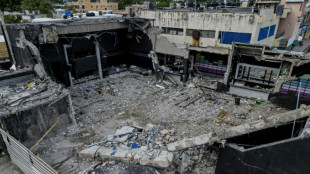
-
 Bucks launch NBA Cup title defense with win over Bulls
Bucks launch NBA Cup title defense with win over Bulls
-
Chinese ship scouts deep-ocean floor in South Pacific

-
 Taiwan badminton star Tai Tzu-ying announces retirement
Taiwan badminton star Tai Tzu-ying announces retirement
-
New York City beat Charlotte 3-1 to advance in MLS Cup playoffs

-
 'Almost every day': Japan battles spike in bear attacks
'Almost every day': Japan battles spike in bear attacks
-
MLS Revolution name Mitrovic as new head coach

-
 Trump gives Hungary's Orban one-year Russia oil sanctions reprieve
Trump gives Hungary's Orban one-year Russia oil sanctions reprieve
-
Owners of collapsed Dominican nightclub formally charged

-
 US accuses Iran in plot to kill Israeli ambassador in Mexico
US accuses Iran in plot to kill Israeli ambassador in Mexico
-
New Zealand 'Once Were Warriors' director Tamahori dies

-
 Hungary's Orban wins Russian oil sanctions exemption from Trump
Hungary's Orban wins Russian oil sanctions exemption from Trump
-
More than 1,000 flights cut in US shutdown fallout

-
 Turkey issues genocide arrest warrant against Netanyahu
Turkey issues genocide arrest warrant against Netanyahu
-
Countries agree to end mercury tooth fillings by 2034

-
 Hamilton faces stewards after more frustration
Hamilton faces stewards after more frustration
-
World's tallest teen Rioux sets US college basketball mark

-
 Trump pardons three-time World Series champ Strawberry
Trump pardons three-time World Series champ Strawberry
-
Worries over AI spending, US government shutdown pressure stocks

-
 Verstappen suffers setback in push for fifth title
Verstappen suffers setback in push for fifth title
-
Earth cannot 'sustain' intensive fossil fuel use, Lula tells COP30

-
 Wales boss Tandy expects Rees-Zammit to make bench impact against the Pumas
Wales boss Tandy expects Rees-Zammit to make bench impact against the Pumas
-
James Watson, Nobel prize-winning DNA pioneer, dead at 97

-
 Medical all-clear after anti-Trump package opened at US base
Medical all-clear after anti-Trump package opened at US base
-
Sabalenka beats Anisimova in pulsating WTA Finals semi

-
 Iran unveils monument to ancient victory in show of post-war defiance
Iran unveils monument to ancient victory in show of post-war defiance
-
MLS Revolution name Mitrovic as hew head coach

-
 Brazil court reaches majority to reject Bolsonaro appeal against jail term
Brazil court reaches majority to reject Bolsonaro appeal against jail term
-
Norris grabs pole for Brazilian Grand Prix sprint race

-
 More than 1,200 flights cut across US in govt paralysis
More than 1,200 flights cut across US in govt paralysis
-
NFL Cowboys mourn death of defensive end Kneeland at 24

-
 At COP30, nations target the jet set with luxury flight tax
At COP30, nations target the jet set with luxury flight tax
-
Trump hosts Hungary's Orban, eyes Russian oil sanctions carve-out

-
 All Blacks 'on edge' to preserve unbeaten Scotland run, says Savea
All Blacks 'on edge' to preserve unbeaten Scotland run, says Savea
-
Alpine say Colapinto contract about talent not money

-
 Return of centuries-old manuscripts key to France-Mexico talks
Return of centuries-old manuscripts key to France-Mexico talks
-
Byrne adamant Fiji no longer overawed by England

-
 Ex-footballer Barton guilty over 'grossly offensive' X posts
Ex-footballer Barton guilty over 'grossly offensive' X posts
-
Key nominees for the 2026 Grammy Awards

-
 Brazil court mulls Bolsonaro appeal against jail term
Brazil court mulls Bolsonaro appeal against jail term
-
Rybakina sinks Pegula to reach WTA Finals title match

-
 Earth 'can no longer sustain' intensive fossil fuel use, Lula tells COP30
Earth 'can no longer sustain' intensive fossil fuel use, Lula tells COP30
-
Kendrick Lamar leads Grammy noms with nine

-
 Ex-British soldier fights extradition over Kenyan woman's murder
Ex-British soldier fights extradition over Kenyan woman's murder
-
Kolisi to hit Test century with his children watching

-
 Alex Marquez fastest in practice ahead of Portuguese MotoGP
Alex Marquez fastest in practice ahead of Portuguese MotoGP
-
Will 'war profiteer' Norway come to Ukraine's financial rescue?

-
 Tech selloff drags stocks down on AI bubble fears
Tech selloff drags stocks down on AI bubble fears
-
Blasts at Indonesia school mosque injure more than 50

-
 Contepomi says lead-in to Wales match a 'challenge' for Argentina
Contepomi says lead-in to Wales match a 'challenge' for Argentina
-
Greece woos US energy deals, as eco groups cry foul


Iran's ancient 'wind catchers' beat the heat naturally
Tall, chimney-like towers rise from centuries-old adobe houses in Iran's desert city of Yazd, drawing in a pleasant breeze for residents of one of the hottest cities on earth.
The wind catchers, called badgirs in Persian, are just one of the engineering marvels inhabitants have developed in this ancient city in central Iran -- where temperatures reach well over 40 degrees celsius (104 Fahrenheit) in the summer.
And, unlike energy-guzzling air-conditioners, they're cost and carbon-free.
"For centuries, before we had electricity, they made it possible to cool dwellings," said Abdolmajid Shakeri, the provincial deputy of Iran's cultural heritage and tourism ministry.
The oldest of the city's 700 wind catchers dates back to the 14th century, but the architectural feature is believed to date back as far as 2,500 years when the Persian Empire ruled over much of the Middle East.
"The badgirs played a key role in the city's prosperity," said Shakeri about the desert city that was a caravan stop on the ancient Silk Road.
"Thanks to them, people lived at ease," he added, describing how the wind catchers pull fresh air into buildings and allow hot air to ventilate out through large vertical slots.
Majid Oloumi, the head of Dowlatabad garden, home to a towering 33-metre (100 foot) wind catcher -- one of the tallest in the world -- described the cooling method as "totally clean because it uses neither electricity nor polluting materials".
UNESCO listed Yazd as a World Heritage Site in 2017, describing the city as a "living testimony to intelligent use of limited available resources in the desert for survival".
-'Simplicity'-
The bioclimatic architecture which provides thermal comfort for the people of Yazd has attracted interest elsewhere on a heating planet.
"Badgirs demonstrate that simplicity can be an essential attribute to sustainability," said Paris-based architect Roland Dehghan Kamaraji, who has studied Iran's wind catchers.
"It goes against the common misconception that sustainable solutions need to be complex or high-tech."
At a sustainable urban community called Masdar city in the United Arab Emirates, buildings have been "designed to make use of the natural ventilation for cooling, like badgirs," he said.
Similarly, ventilation inspired by "termite mounds, an approach similar to that of badgirs" were built atop Eastgate Centre, a shopping mall and office complex in Harare, Zimbabwe.
However, Yazd's unique architectural traditions have largely been abandoned at their birthplace.
"Unfortunately, our ancestral heritage has been forgotten," especially since the emergence of air conditioners, said Oloumi.
Yazd's old town is a labyrinth of narrow streets and roofed alleyways. Its centuries-old edifices made of clay, mud-brick and adobe all provide insulation against the torrid heat.
But the old houses stand in sharp contrast to modern cement buildings and multi-lane roads.
"Today, house architecture imitates that in other countries, and cement-based construction does not correspond to the climate of Yazd," he added.
Kamaraji says bioclimatic architecture has waned due to economic constraints and modern construction methods that "largely favour the use of energy and fossil fuel intensive materials".
- Old but effective -
Another sustainable architectural feature of Yazd is its system of underground aqueducts called qanats, which transport water from underground wells, aquifers or the mountains.
"These underground aqueducts have great utility," said Zohreh Montazer, an expert on the water system. "They constitute a source of water supply and make it possible to cool the dwellings and to preserve food at an ideal temperature."
Iran is estimated to have around 33,000 operational qanats today, a significant drop from the 50,000 in use in the mid-20th century.
UNESCO says the decline in qanats is driven in part by the drying up of underground water sources due to overconsumption.
Iranian authorities have in recent years sought to rehabilitate the qanat of Zarch -- considered the longest and oldest, dating to some 3,000 years ago.
The water network -- which stretches over 70 kilometres across Yazd, and runs at a depth of around 30 metres -- stands as a reminder for Yazd's residents of the challenges ahead.
"The day when fossil fuels run out," said Montazer, "we will have to return to these methods."
Z.AbuSaud--SF-PST
